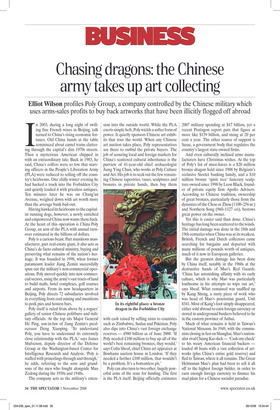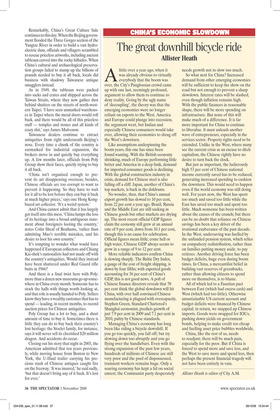Chasing dragons: the Chinese army takes up art collecting
Elliot Wilson profiles Poly Group, a company controlled by the Chinese military which uses arms-sales profits to buy back artworks that have been illicitly flogged off abroad In 2003, during a long night of swilling fine French wines in Beijing, talk turned to China’s rising economic fortunes. Old China hands at the table reminisced about camel trains clattering through the capital’s dim 1970s streets. Then a mysterious American chipped in with an extraordinary tale. Back in 1983, he said, China’s coffers were so low that starving officers in the People’s Liberation Army (PLA) were reduced to selling off the country’s heirlooms. One chilly winter evening he had backed a truck into the Forbidden City and quietly loaded it with priceless antiques. Ten minutes later he was on Chang’an Avenue, weighed down with art worth more than the average bank bail-out.
Having hawked its heirlooms to the capitalist running dogs, however, a newly enriched and empowered China now wants them back. At the heart of this operation is China Poly Group, an arm of the PLA with annual turnover estimated in the billions of dollars.
Poly is a curious beast. Part munitions manufacturer, part real-estate giant, it also acts as China’s de facto cultural ministry, buying and preserving what remains of the nation’s heritage. It was founded in 1998, when former paramount leader Jiang Zemin successfully spun out the military’s non-commercial operations. Poly moved quickly into new commercial sectors, using the army’s vast tracts of land to build malls, hotel complexes, golf courses and airports. From its new headquarters in Beijing, Poly directs 72 subsidiaries involved in everything from coal mining and munitions to pork pies and hostess bars.
Poly itself is ruled from above by a rogues’ gallery of senior Chinese politburo and military officials. At the top sits Major General He Ping, son-in-law of Jiang Zemin’s predecessor Deng Xiaoping. ‘To understand Poly, you have to understand its extremely close relationship with the PLA,’ says James Mulvenon, deputy director of the Defense Group at the Washington-based Center for Intelligence Research and Analysis. ‘Poly is staffed with princelings through and through,’ he adds, referring to the sons and grandsons of the men who fought alongside Mao Zedong during the 1930s and 1940s.
The company acts as the military’s exten sion into the outside world. While the PLA exerts simple heft, Poly wields a softer form of power. It quietly sponsors Chinese art exhibits that tour the world. When any Chinese art auction takes place, Poly representatives are there to outbid the private buyers. The job of scouring local and foreign markets for China’s scattered cultural inheritance is the purview of 41-year-old chief archaeologist Jiang Ying Chun, who works at Poly Culture and Art. His job is to seek out the few remaining Chinese tapestries, vases, sculptures and bronzes in private hands, then buy them with cash raised by selling arms to countries such as Zimbabwe, Sudan and Pakistan. Poly also dips into China’s vast foreign exchange reserves — £980 billion as of June 2008. ‘If Poly needed £100 million to buy up all of the world’s best remaining bronzes, they would,’ says Colin Sheaf, chief China art appraiser at Bonhams auction house in London. ‘If they needed a further £100 million, that wouldn’t be a problem. It’s a bottomless pit.’ Poly can also turn to two other, hugely powerful arms of the state for funding. The first is the PLA itself. Beijing officially estimates 2007 military spending at $47 billion, yet a recent Pentagon report puts that figure at more like $139 billion, and rising at 20 per cent a year. The other source of support is Sasac, a government body that regulates the country’s largest state-owned firms.
And even culturally inclined arms manufacturers have Christmas wishes. At the top of Poly’s list of must-haves is a $20 million bronze dragon held since 1908 by Belgium’s reclusive Stoclet banking family, and a $10 million bronze ‘spirit tree’ funerary sculpture owned since 1998 by Leon Black, founder of private equity firm Apollo Advisers. According to Chinese tradition, ownership of great bronzes, particularly those from the dynasties of the Chou or Zhou (1100–256 BC) and Northern Song (960–1127 AD), bestows great power on the owner.
Yet this is easier said than done. China’s heritage has long been scattered to the winds. The initial damage was done in the 18th and 19th centuries when China was at its weakest. British, French and Dutch collectors came searching for bargains and departed with many millions of pounds worth of antiques, much of it now in European galleries.
But the greatest damage has been done by China itself, notably in the 1960s at the destructive hands of Mao’s Red Guards. ‘China has astonishing affinity with its early culture, which is why Mao was particularly loathsome in his attempts to wipe out art,’ says Sheaf. What remained was snaffled up by Kang Sheng, a nasty piece of work who was head of Mao’s praetorian guard, Unit 8341. Most of Kang’s loot simply disappeared, either sold abroad to earn foreign currency or stored in underground bunkers believed to lie in the eastern province of Anhui.
Much of what remains is held in Taiwan’s National Museum. In 1949, with the communists closing in fast on Shanghai, Mao’s nationalist rival Chiang Kai-shek — ‘Cash-my-check’ to his weary American financial backers — loaded 48 boats with a vast collection of artworks (plus China’s entire gold reserve) and fled to Taiwan, where it all remains. The Great Helmsman Mao’s plan had been to sell it all off to the highest foreign bidder, in order to earn enough foreign currency to finance his mad plans for a Chinese socialist paradise. Remarkably, China’s Great Culture Sale continues to this day. When the Beijing government flooded the Three Gorges section of the Yangtze River in order to build a vast hydroelectric dam, officials and villagers scrambled to rescue priceless artworks, including ancient tableaux carved into the rocky hillsides. When China’s cultural and archaeological preservation groups failed to stump up the billions of pounds needed to buy it all back, locals did business with shadowy Taiwanese antique smugglers instead.
As in 1949, the tableaux were packed into sacks and crates and shipped across the Taiwan Straits, where they now gather dust behind shutters on the streets of north-western Taipei. ‘I have seen unmarked warehouses in Taipei where the metal doors would roll back, and there would be all of this priceless stuff — temples and stones and all kinds of crazy shit,’ says James Mulvenon.
Taiwanese dealers continue to extract antiquities from right underneath Beijing’s nose. Every time a chunk of the country is earmarked for industrial expansion, the brokers move in and quietly buy everything up. A few months later, officials from Poly Group show their faces, quietly trying to buy it all back.
‘China isn’t organised enough to prevent its art disappearing overseas; besides, Chinese officials are too corrupt to want to prevent it happening. So they have to wait for it all to be lost before they can buy it back at much higher prices,’ says one Hong Kongbased art collector. ‘It’s a weird system.’ And China cannot admit that it has largely got itself into this mess. ‘China lumps the loss of its heritage into a broad ambiguous statement about foreigners looting the country,’ notes Colin Sheaf of Bonhams, ‘rather than admitting Mao’s terrible mistakes, and his desire to loot his own country.’ It’s tempting to wonder what would have happened if European collectors and Chiang Kai-shek’s nationalists had not made off with the country’s antiquities. Would they instead have been shattered under Red Guard rifle butts in 1966?
And there is a final twist here with Poly: more than a dozen new museums go up somewhere in China every month. Someone has to stock the halls with things worth looking at, and that role is usually handed to Poly. Sellers know they have a wealthy customer that has to spend — leading, in recent months, to record auction prices for Chinese antiquities.
Poly Group has a lot to buy, and a short amount of time to buy it. Sometimes there is little they can do to buy back their country’s lost heritage: the Stoclet family, for instance, says it will never sell its cherished $20 million dragon. And accidents do occur.
Closing out his story that night in 2003, the American admitted that ten years previously, while moving house from Boston to New York, the U-Haul trailer carrying his precious stash of Chinese antiques caught fire on the freeway. ‘It was insured,’ he said sadly, ‘but that doesn’t bring any of it back. It’s lost for ever.’



































































































 Previous page
Previous page